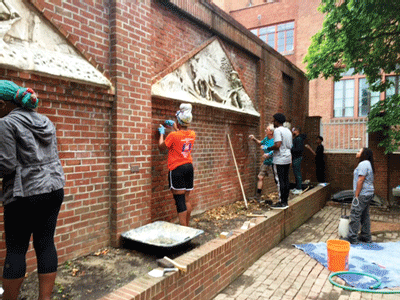The numbers are glaring, disconcerting at best.
Only five percent of architecture students are black, according to data from the National Architectural Accrediting Board, and a meager 0.3 percent of licensed architects are African American women. However, all of that could soon change.
A pilot program is underway to bring African American young professionals into historic preservation and related career paths, such as architecture and conservation, and raise awareness of the cultural legacy of Historically Black Colleges and Universities (HBCUs).
The Advisory Council on Historic Preservation (ACHP) is partnering with the National Trust for Historic Preservation’s HOPE Crew; Morgan State University (MSU) in Baltimore; and the National Park Service’s Western Center for Historic Preservation on the program called, “Touching History: Preservation in Practice.”
Six MSU architecture students spent 11 days training at the Center, located at White Grass Ranch in Grand Teton National Park in Jackson Hole, Wyoming.
“This is something that has been near and dear to my heart for many years and something that the advisory council has been open to for many years,” said Susan Glimcher, the director, of Communications, Education and Outreach at the Advisory Council on Historic Preservation.
The MSU students are currently working with the HOPE Crew rehabilitating the courtyard at the Peale Center for Baltimore History and Architecture in Baltimore.
The oldest museum building in America, the house was built by Rembrandt Peale and was used as Baltimore City Hall for a number of years. It later served as the Municipal Museum of the City of Baltimore until it closed in 1997 due to lack of funds. It sat vacant for 20 years until it was reopened as a city cultural center.
The students are scheduled to undergo additional training from July 23-27 at the National Park Service’s Historic Preservation Training Center in Frederick, Maryland.
They will be taking field trips to historic places in the Baltimore-Washington, D.C. area in their final week, July 30-August 4.
The project is being funded by the National Park Service with in-kind donations from the ACHP and the National Trust’s African American Cultural Heritage Action Fund.
As a final project in “Touching History: Preservation in Practice,” the students will create a portfolio that will point out the importance of preserving and restoring the historic buildings that are a part of the MSU campus, Glimcher said.
MSU has 20 structures eligible for listing on the National Register of Historic Places.
In addition, in 2016, the National Trust designated the university as a National Treasure and is partnering with the school to develop a preservation plan.
“We are very pleased in that two things connect here. First, it’s engaging young people in historic preservation, a field that doesn’t have enough young people involved and we’ve been working on an effort to build a more inclusive field,” Glimcher said.
Under the current landscape, the architectural and historic preservation landscape is dominated by older white individuals, Glimcher said.
“Obviously, it isn’t the true history of the United States of America and that matters,” she said.
“We are looking at how to make a difference.”
Overall, the effort is part of the new program that officials hope will bring African American young professionals into historic preservation and related career paths, such as architecture and conservation, and raise awareness of the cultural legacy of HBCUs.
“Historic preservation is extremelyimportant,” Glimcher said. “This experience has inspired me to go find out where our history is. A lot of our history is repressed and lost. It’s ignored.”
Morgan is the first HBCU to implement a “Preservation in Practice” program and the collaborators said they plan to introduce it at other HBCUs in the future.
Glimcher said she hopes the diversification of architecture-related fields will lead to a more accurate portrayal of history.
“We wanted to raise awareness to the rich history of the HBCU legacy,” Glimcher said. “They’re also losing their heritage and we want to get more of these HBCUs into restoring their schools.”
